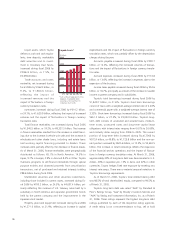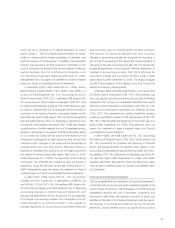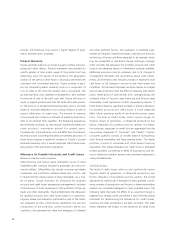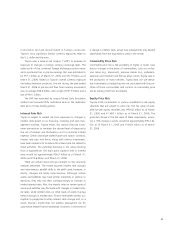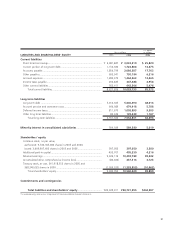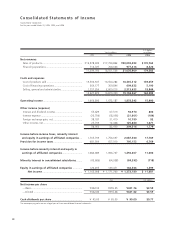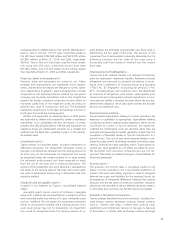Toyota 2006 Annual Report Download - page 85
Download and view the complete annual report
Please find page 85 of the 2006 Toyota annual report below. You can navigate through the pages in the report by either clicking on the pages listed below, or by using the keyword search tool below to find specific information within the annual report.
83
in Toyota’s financial services operations as any change impacts
most significantly on the financial services operations.
Yen in millions
Effect on the allowance
for credit losses
as of March 31, 2006
10 percent increase in
expected loss severity .......................................... ¥4,581
Investment in Operating Leases
Natures of estimates and assumptions
Vehicles on operating leases, where Toyota is the lessor, are val-
ued at acquisition cost and depreciated over their estimated
useful lives using the straight-line method to their estimated
residual values. Toyota utilizes industry published information
and its own historical experience to determine estimated resid-
ual values for these vehicles. Toyota evaluates the recoverability
of the carrying values of its leased vehicles for impairment when
there are indications of declines in residual values, and if
impaired, Toyota recognizes an allowance for its residual values.
In addition, to the extent that sales incentives remain an integral
part of sales promotion with the effect of reducing new vehicle
prices, resale prices of used vehicles and, correspondingly, the
fair value of Toyota’s leased vehicles could be subject to down-
ward pressure. If resale prices of used vehicles decline, future
operating results of the financial services operations are likely to
be adversely affected by incremental charges to reduce estimat-
ed residual values. Throughout the life of the lease, manage-
ment performs periodic evaluations of estimated end-of-term
market values to determine whether estimates used in the
determination of the contractual residual value are still consid-
ered reasonable. Factors affecting the estimated residual value
at lease maturity include, but are not limited to, new vehicle
incentive programs, new vehicle pricing, used vehicle supply,
projected vehicle return rates, and projected loss severity. The
vehicle return rate represents the number of leased vehicles
returned at contract maturity and sold by Toyota during the
period as a percentage of the number of lease contracts that, as
of their origination dates, were scheduled to mature in the
same period. A higher rate of vehicle returns exposes Toyota to
higher potential losses incurred at lease termination. Loss severi-
ty is the extent to which the end-of-term market value of a lease
is less than its carrying value at lease end.
Sensitivity analysis
The following table illustrates the effect of an assumed change
in the vehicle return rate, which we believe is one of the critical
estimates, in determining the allowance for residual value, hold-
ing all other assumptions constant. The following table repre-
sents the impact on the allowance for residual values in
Toyota’s financial services operations as those changes impact
significantly on financing operations.
Yen in millions
Effect on the allowance
for residual value
as of March 31, 2006
5 percent increase in vehicle return rate...................... ¥470
Impairment of Long-Lived Assets
Toyota periodically reviews the carrying value of its long-lived
assets held and used and assets to be disposed of, including
goodwill and other intangible assets, when events and circum-
stances warrant such a review. This review is performed using
estimates of future cash flows. If the carrying value of a long-
lived asset is considered impaired, an impairment charge is
recorded for the amount by which the carrying value of the
long-lived asset exceeds its fair value. Management believes that
the estimates of future cash flows and fair values are reason-
able; however, changes in estimates of such cash flows and fair
values would affect the evaluations and negatively affect future
operating results of the automotive operations.
Pension Costs and Obligations
Natures of estimates and assumptions
Pension costs and obligations are dependent on assumptions
used in calculating such amounts. These assumptions include
discount rates, benefits earned, interest costs, expected rate of
return on plan assets, mortality rates and other factors. Actual
results that differ from the assumptions are accumulated and
amortized over future periods and, therefore, generally affect
recognized expense and the recorded obligations in future peri-
ods. While management believes that the assumptions used are
appropriate, differences in actual experience or changes in
assumptions may affect Toyota’s pension costs and obligations.
The two most critical assumptions impacting the calculation
of pension costs and obligations are the discount rates and the
expected rates of returns on plan assets. Toyota determines the
discount rates mainly based on the rates of high quality fixed
income bonds or fixed income governmental bonds currently





